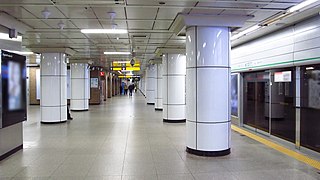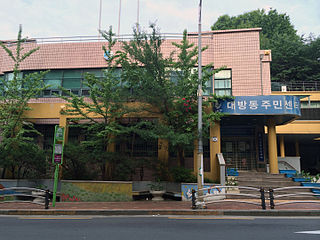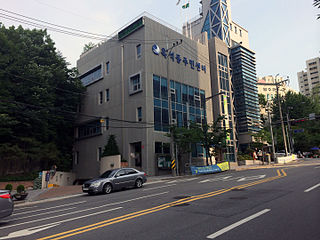Related Research Articles

Sadang Station is a station on the Seoul Subway Line 2 and Seoul Subway Line 4 in South Korea.

The Seoul National Cemetery (Korean: 국립서울현충원) is located in Dongjak-dong, Dongjak-gu, Seoul, South Korea. The cemetery is reserved for Korean veterans, including those who died in the Korean independence movement, Korean War, and Vietnam War. Four South Korean presidents are buried in the cemetery.
Yuhan Corporation is a South Korean pharmaceutical and chemical company headquartered in Daebang-dong, Dongjak-gu, Seoul. It was established in 1926 by New Il-han and has been listed on the Korea Stock Exchange since 1962. Yuhan is one of the top Korean pharmaceutical companies, along with Celltrion, Samsung Biologics, GC Pharma, and Hanmi Pharmaceutical.

Yeongdeungpo District is an administrative district in southwest Seoul, South Korea. Although the origin of the name is uncertain, the first two syllables are thought to be from "yeongdeung" (靈登) or "divine ascent", a shamanic rite. The third syllable is "po", representing the bank of a river (浦), referring to the district's position on the Han River. The 2006 population was 408,819.
Yu Seong-won was a scholar-official of the early Joseon Dynasty, who is remembered as one of the six murdered ministers. He was born to a yangban family of the Munhwa Ryu lineage, but his date of birth is not known.

Gwanak District (Gwanak-gu) is an administrative subdivision (gu) of Seoul, South Korea. It lies on the southern skirt of Seoul, bordering Anyang of Gyeonggi Province. The southern border of Gwanak-gu, bordering Anyang, consists of the craggy ridgeline of Gwanaksan, which dominates the local geography.

Seocho District is one of the 25 local government districts which make up the city of Seoul, South Korea. Seocho is considered a part of the Gangnam region, along with the Gangnam and Songpa districts of Seoul. Seocho District ranks as one of the richest neighborhoods in South Korea and among the most expensive areas in Seoul with an average sales price of 47.75 million South Korean won per 3.3 square meters. Many of the wealthiest residents are concentrated in the three Gangnam districts including Seocho, known as Gangnam School District Eight.

Ichon Station is a station in Yongsan-gu, Seoul on Seoul Subway Line 4 and the Gyeongui–Jungang Line. This station is the closest to the National Museum of Korea, situated in the interior of Yongsan Family Park. It also serves eastern Ichon-dong, home to the largest Japanese community in South Korea with some 1,300 Japanese residents.

Dongjak District (Dongjak-gu) is one of the 25 gu that make up the city of Seoul, South Korea. Its name was derived from the Dongjaegi Naruteo Ferry, on the Han River which borders the district to the north. It was the 17th gu created in Seoul, after being separated from Gwanak District on 1 April 1980.

Noryangjin Station is a metro station in central Seoul, South Korea. The station is located in the Noryangjin-dong (neighborhood) of Dongjak-gu (ward) and is also a stop on Seoul Subway Line 1 and Seoul Subway Line 9. This stop is a popular destination for those seeking to eat raw fish, and other assorted seafood, as a large, covered sea food market is located next to the station, accessible by foot bridge. The Line 1 station is also notable in that Exit 1 and 2 have the same number as Exit 1 and 2 of Line 9's station.
Bon-dong is a dong, neighbourhood of Dongjak-gu in Seoul, South Korea.

Daebang-dong is a dong, neighbourhood of Dongjak-gu in Seoul, South Korea.

Heukseok-dong is a dong, neighbourhood of Dongjak-gu in Seoul, South Korea.
Noryangjin-dong is a dong, neighbourhood of Dongjak-gu in Seoul, South Korea.
Sadang-dong is a dong (neighborhood) of Dongjak-gu in Seoul, South Korea.
Sangdo-dong is a dong, neighbourhood of Dongjak-gu in Seoul, South Korea.
Sindaebang-dong is a dong, neighbourhood of Dongjak-gu in Seoul, South Korea.
Dalmasa is a Buddhist temple of the Jogye Order in Seoul, South Korea. It is located in 61-34 Heukseok 1-dong in the Dongjak-gu area of the city.

Noryangjin Fisheries Wholesale Market or shortly Noryangjin Fish Market is an extensive farmers fish market in the neighborhood of Noryangjin-dong in Dongjak-gu, Seoul, South Korea. It is located east of 63 Building, and just south of the Han River. Metro line One passes through at Noryangin station near-by. Exit the station at exit 1 and walk under the bridge.
Siheung County, alternatively Shihŭng County was a county (gun) in Gyeonggi Province, South Korea. This county was abolished in 1989 as its one town(읍) of Sorae and two townships(면) of Gunja and Suam became Siheung City at the same time. Today's Siheung City area did not belong to Siheung County before 1914. The area rather was part of old Incheon or Ansan.
References
- 1 2 "동작동 (Dongjak-dong 銅雀洞)" (in Korean). Doosan Encyclopedia. Retrieved 2008-04-17.[ permanent dead link ]